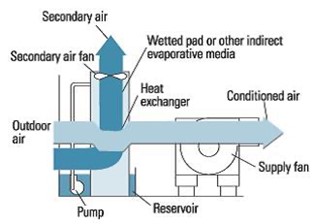Evaporative cooling is a technology that utilizes evaporation and blowing air to cool buildings. It may be the sole cooling source, or it may be combined with an air conditioning system.
In general, there are three types of evaporative cooling systems found in commercial buildings:
- direct evaporative cooling,
- indirect evaporative cooling, and
- direct/indirect evaporative cooling.
Types of Evaporative Cooling
Direct Evaporative Cooling
Direct evaporative cooling is the most commonly used technology in residential applications. This type of unit is widely referred to as a swamp cooler. Direct evaporative cooling cools the air by evaporating water and increasing the moisture content of the air. A blower guides air across a media component, such as a wetted pad, which is continually saturated with water to facilitate heat transfer from the warm water to the cooler air. Excess water is collected at the bottom of the cooling media, and a pump recirculates it from the reservoir. A float valve controls the water level. Then, a fan pushes the fresh, cool, humidified air out of the unit. Direct evaporative cooling is best suited for hot and dry climates.
There are three basic ways to mount this type of system: a wall-mounted platform; a roof-mounted platform; or mounted on the hard ground (less common). The system can be ducted into a diffuser or distributed via nozzles fitted to the ducting. To assess these units, please refer to CCPIA’s Evaporative Cooler/Swamp Cooler Inspection Checklist.
Indirect Evaporative Cooling
 Indirect evaporative cooling uses an air-to-air heat exchanger to remove heat from the air. Unlike direct evaporative cooling, the primary air in an indirect evaporative system doesn’t come in direct contact with the moist air in the heat exchanger. The main blower fan supplies outside air that is cooled by passing through the heat exchanger as it is drawn into the building. A secondary fan draws exhaust air from the building and/or outside air through wet pads, providing cool air, which takes heat from the incoming supply air as the two air flows cross paths in the heat exchanger. Hence, the moist air is exhausted while cooled dry air is blown into the space.
Indirect evaporative cooling uses an air-to-air heat exchanger to remove heat from the air. Unlike direct evaporative cooling, the primary air in an indirect evaporative system doesn’t come in direct contact with the moist air in the heat exchanger. The main blower fan supplies outside air that is cooled by passing through the heat exchanger as it is drawn into the building. A secondary fan draws exhaust air from the building and/or outside air through wet pads, providing cool air, which takes heat from the incoming supply air as the two air flows cross paths in the heat exchanger. Hence, the moist air is exhausted while cooled dry air is blown into the space.
Another design for this type of heat exchanger features a series of metal tubes that aid in the transfer of heat without adding moisture to the air before it’s blown through ductwork to the building’s interior.
Indirect evaporative cooling may be combined with traditional, compressor-based cooling methods (not running simultaneously) as an outside air pre-cooler, or in cooling towers. A cooling system utilizing this type of technology is typically roof-mounted. This cooling method is more suitable for areas where additional humidity isn’t desirable for interior air.
Direct/Indirect Evaporative Cooling
Indirect cooling systems may be combined with a second direct evaporative cooling stage before the conditioned air enters the building to further lower the temperature of incoming air. This two-stage system is typically referred to as indirect/direct evaporative cooling (or IDEC) systems.
Conclusion
Commercial buildings utilize evaporation and fans in a packaged unit to cool air. The three types of evaporative cooling technologies include direct evaporative cooling, indirect evaporative cooling, and direct/indirect evaporative cooling. In direct evaporative cooling systems, supply air comes in direct contact with a wetted media that add moisture to the air. The result is fresh, cool, humidified air. In indirect evaporative cooling systems, no moisture is added to the supply air. It is “indirectly” cooled by passing through a heat exchanger. Direct/indirect evaporative cooling is a combination of the two systems. Depending on the subject property’s size, geographic location, and cooling design and needs, inspectors will come across an array of evaporative cooling equipment.
Article Written By: Rob Claus, CMI® and Maggie Aey
Additional Resources for Commercial Property Inspectors:


